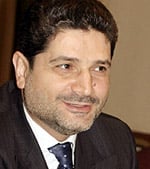Though the new “Law on currency regulation and control” is applied since June 28 (according to which foreign currency circuit in the country is limited), US dollars is still the main mean of currency to pay for products. Of course in this case the CB is faced with a problem when carrying out its monetary policy: how to evaluate the cash circuit of foreign currencies in our economy. With this purpose the statistics department of the CB questions people. At the same time they don’t ask these questions to find out the real capacity level of currency, but to find out the proportion of currencies that people have with them.
Yesterday the CB head Tigran Sargsyan published the results of these activities, and alas, the dollar still continues to play a key role in our economy. They have questioned 2010 families, 59,3 % out of which were in Yerevan, 22,2 % – in other cities, and 18,5 % – in villages. As a result of these surveys it turned out that this year the foreign currency capacity circuit in our economy covers 81,4 % (it was 84 % last year and 79 % – in 2003). By the way, this mark covers 11 % for poor people, and about 98 % for rich people. The US dollar still plays a key role in our economy, but on the other hand rich families lose as a result of exchange rate decrease for USD. The situation is the following in numbers: this year the foreign currency circuit in our economy covered a sum equal to 1,50 billion dollars (about 1 billion out of this capacity is USD). For comparison, it is worth to mention that in 2006 the budget expenses are supposed to cover 1 billion too.
There are small developments in comparison with the same marks of last year. In 2004 only the 17 % of our population preferred to use dram, now this mark covers 32,9 %. The public income from foreign money transfers has gone down and covers 23,8 %. But there have been some interesting changes in the way the transfers flow. Before they used to make transfer via bank services (about 50 % of all transfers from abroad), but now they prefer other means more. The main reasons for this change are the lack of trust in banks and the existing high banking commissions. Most of the money transfers from Russia are made via banks, and most of the transfers from the USA are made via private companies. By the way, about 40 % of the transfers to Armenia come from Russia, and about 30 % – from the USA.
In the period of July-September the CB made monitoring in the customs points of Zvartnots Airport, Meghri, Bagratashen and Bavra. The highest capacity of foreign currency flow was registered at the airport (the in-flow was more than the out-flow). So, it has already been 12 years that we have our own currency, but we still don’t feel that. One of the reasons is the fact that Armenia is one of the countries in the world that has open economies. The Armenian dram can be exchanged only in Armenia, and a lot of Armenians work abroad. So our country, our businessmen and our economy depend on some other external developments (mostly USD). And it would be a waste of time to speak about cutting down the “dollarization” level in our economy until this problem is solved globally. As we can see, even the law that has been passed for about a half year can not do anything either.
P.S. By the way, there have been attempts to calculate the level of unemployment in our country with the help of questioning- 28 % of people that were questioned were unemployed.

